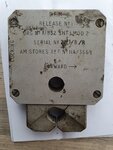Djbeffects
Airman
- 14
- Jun 6, 2021
Hi Everyone I'm new here this is my first post so excuse me if I've not posted in the correct format.
I have recently purchased several small bomb release catches.
Not sure if they come under Avionics as they are electrically triggered?
I'm trying to get them working from 28v DC power source but am not having much luck. I have a horrid feeling they may be AC.
Is there anyone out there with more knowledge on these?
If they are AC can they be converted to DC?
Any help would be much appreciated.
Regards
Dominic
I have recently purchased several small bomb release catches.
Not sure if they come under Avionics as they are electrically triggered?
I'm trying to get them working from 28v DC power source but am not having much luck. I have a horrid feeling they may be AC.
Is there anyone out there with more knowledge on these?
If they are AC can they be converted to DC?
Any help would be much appreciated.
Regards
Dominic

